Dog owners must consider several factors when choosing the right dog crate size for their precious pooch. Breed and size are, of course, important when choosing the most appropriate crate size and type, but the dog’s health and temperament and the area you live in also play a part!
Read on to find out how to find the right dog crate size for your pup based on their breed, size, health history, and Australia’s standard dog crate sizes.
How to Measure Your Dog to Fit Their Crate
Measuring your dog to choose the right dog crate size is fairly straightforward. Position your dog so they’re standing up tall and straight. Using a measuring tape, measure the length from the tip of the nose to the base of the tail — do not include the tail itself — to get your dog’s length.
When measuring height, measure from the highest point on the head both when the dog is sitting down and standing up.
Take the longer of the two measurements and add 2 inches — this will give you the shortest height the crate should be.
IATA Approved Travel Dog Crate Sizes, Measurements, and Requirements.
The International Air Transport Association (IATA) have set pet carrier standards which all airlines must meet for pet travel. These travel crates have slightly different regulations than your average home crates.
Australian airlines have to impose weight requirements in addition to regulating dog crate sizes. Your dog should be able to sit, lie down, and turn around in their travel crate comfortably.
In addition to height and length, you’ll also need to measure leg height and width.
To measure leg height, measure from the floor to the dog’s elbow joint. Don’t include the shoulder in this measurement.
To find your dog’s width, simply measure across the widest point (usually the belly or the head).
Measuring height for travel crates also works slightly differently. You’ll need to measure from the floor to the tips of the ears (or to the top of the head — whichever is higher) rather than the shoulders.
Know your dogs weight as travel crates have a maximum weight capacity.
Dog Crate Sizes by Breed
Remember, the best type of crate — wire, plastic, etc. — for your dog is based more on their temperament rather than their size.
Extra-small breeds.
Includes:
Welsh Corgis, Miniature Schnauzers, Boston Terriers, French Bulldogs, Lhasa Apsos, Miniature Dachshunds, Miniature Pinscher, Miniature Schnauzer, Papillon, Pekingese, Brussels Griffon, Bolognese, Chihuahua, Pug, Maltese, Toy Manchester Terrier, Pomeranian, Toy Poodle, Silky Terrier, Toy Fox Terrier, Yorkshire Terrier, and similarly sized breeds.
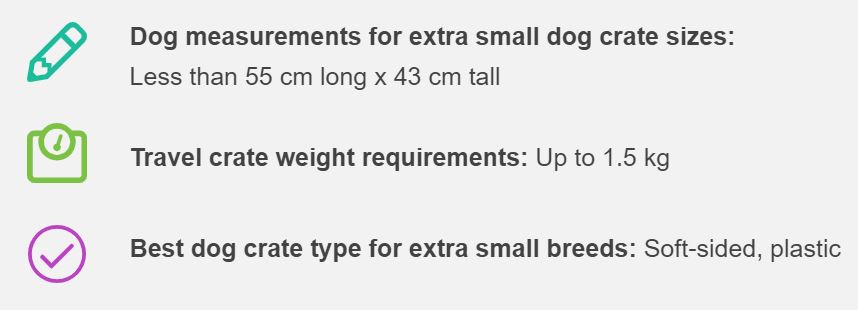
Small breeds
Includes:
Welsh Corgis, Miniature Schnauzers, Boston Terriers, French Bulldogs, Lhasa Apsos, dachshunds, Australian Terrier, Basenji, Pug, Bichon Frise, Border Terrier, Brussels Griffon, Cairn Terrier, Cavalier King Charles Spaniel, Dachshund, Havanese, Italian Greyhound, Jack Russell, Lhasa Apso, Maltese, Maltese Shih Tzu, Miniature Bull Terrier, Miniature Pinscher, Papillon, Miniature Poodle, Pekingese, Pomeranian, Schnauzer, Scottish Terrier, Welsh Corgi, Welsh Terrier, West Highland White Terrier, Yorkshire Terrier, and similarly sized breeds.
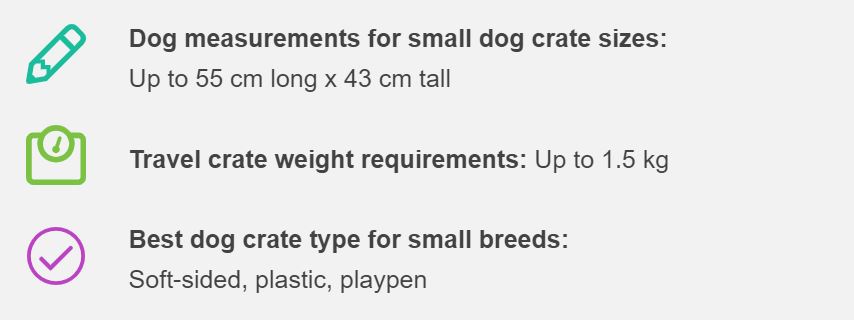
Medium-sized breeds
Includes:
Border Collies, Cocker Spaniels, Fox Terriers, Beagles, American Bulldog, American Staffy, Australian Kelpie, Blue Heeler / Australian Cattle Dog, Border Collie, Cavoodle, Cocker Spaniel, Dalmatian, English /British Bulldog, Irish Terrier, Old English Sheepdog, Portuguese Water Dog, Schnauzer, Shar Pei, Shetland Sheepdog, Soft-Coated Wheaten Terrier, Springer Spaniel, Whippet and similarly sized breeds.
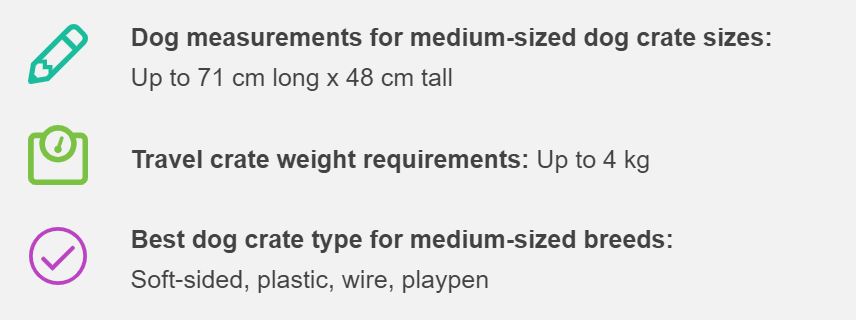
Large breeds.
Includes:
Beagles, Cocker Spaniels, Chow Chows, Dalmatians, Cattle Dogs, Airedale Terrier, Akita, Alaskan Malamute, Australian Shepherd, Basset hound, Bernese Mountain Dog, Boerboel, Boxer, Bull Terrier, Bullmastiff, Cane Corso, Chow Chow, Rough Collie, Doberman Pinscher, Dogue De Bordeaux, English Pointer, German Shepherd, Golden Retriever, Great Dane, Goldendoodle, Hungarian Vizsla, Irish Setter, Labradoodle, Labrador, Newfoundland, Pitbull Terrier, Poodle, Portuguese Water Dog, Rhodesian Ridgeback, Rottweiler, Samoyed, Siberian Husky, Weimaraner, and similarly sized breeds.
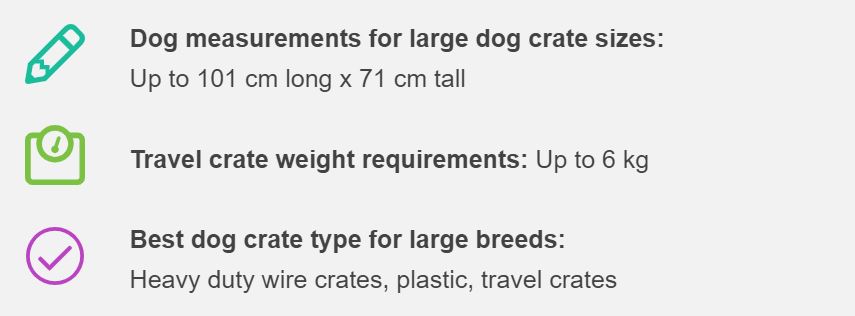
Extra large breeds.
Includes:
Saint Bernards, Great Danes, Newfoundlands, Rottweilers, Boxers, Bernese Mountain Dog, Bullmastiff, Doberman Pinscher, Dogue De Bordeaux, English Pointer, German Shepherd, Golden Retriever, Great Dane, Goldendoodle, Hungarian Vizsla, Irish Setter, Newfoundland, Pitbull Terrier, Poodle, Portuguese Water Dog, Rhodesian Ridgeback, Rottweiler, Siberian Husky, Weimaraner and similarly sized dogs.
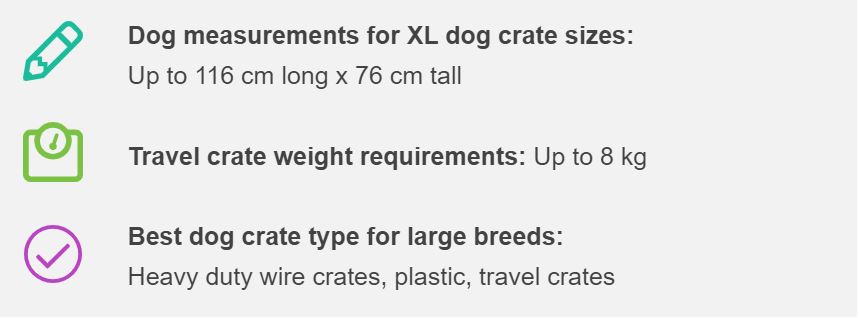
Dog Crate Sizes by Temperament
Temperament plays a much more important role in choosing the right dog crate size than you might think!
Typically we can categorise our dogs into the following temperament classes:
- Destructive
- Calm
- High energy
- Anxious
Destructive.
The materials used in wire and plastic crates are durable, making it harder for your dog to destroy. If your dog is a chewer, we recommend wire.

Calm.
Calm, small-breed dogs who don’t tend to chew on things may feel more at home in a soft-sided crate than a wire or plastic crate.
Stylish designer crates are also available and can double as furniture, and are ideal for very well-trained dogs.

High energy.
Wire and plastic crates are durable, but if you have a large and highly energetic dog, or a “Houndini” who likes to escape, you may want to look into a reinforced steel or plastic crate.
If your dog is hyperactive in their crate, try setting down blankets or padding the bars and metal flooring to reduce noise.

Anxious.
Although they can be noisier than some other crate types, wire crates are well-ventilated and provide optimum visual range.
Plastic crates may make anxious dogs feel cramped. Dogs with anxiety may chew soft-sided crates, which are also harder to clean.

Australian Standard Dog Crate Sizes
Not all crates are created equal! Different types of crates come in different standard sizes.
Here are the standard dimensions you should expect to find when shopping for a specific type of crate in Australia.
Soft-sided crates
Extra small: 61 cm long x 43 cm wide x 48 cm high
Medium: 76 cm long x 48 cm wide x 53 cm high
Large: 92 cm long x 59 cm wide x 64 cm high
Extra large: 107 cm long x 71 cm wide x 76 cm high
XXL: 122 cm long x 76 cm wide x 81 cm high
Wire crates
Medium: 61 cm long x 45.7 cm wide x 50.8 cm high
Large: 122 cm long x 79 cm wide x 84 cm high
Portable crates
Small: 48 cm long x 41 cm wide x 41 cm high
Medium: 76 cm wide x 51 cm long x 48 cm high
Large: 91 cm wide x 61 cm long x 58 cm high
Travel crates (IATA approved carriers)*
Small: 53 cm long x 37 cm wide x 37 cm high — for dogs weighing up to 1.5 kg
Medium: 62 cm long x 43 cm wide x 44 cm high — for dogs weighing up to 4 kg
Large: 73 cm long x 44 cm wide x 53 cm high — for dogs weighing up to 5.8 kg
Extra large: 82 cm long x 56 cm wide x 60 cm high — for dogs weighing up to 6 kg
XXL: 94 cm long x 62 cm wide x 74 cm high — for dogs weighing up to 8 kg
*Note that IATA approved carriers also have weight restrictions for dogs and their respective crate sizes.
Playpen crates
Medium: 92 cm long x 49 cm wide
Extra Large: 120 cm long x 82 cm wide
Dog Crate Sizes for Dogs with Health Issues
Certain breed-related health issues play a really important role in choosing the right dog crate size and the type of crate most appropriate for your dog.
Dogs suffering from hip dysplasia should have a large crate, even if they’re a small breed. Small crates can be too cramped, which may exacerbate the dog’s hip problems.
However, according to the Textbook of Small Animal Orthopedics, young dogs who are genetically predisposed for hip dysplasia — meaning they’re descended from dogs diagnosed with hip dysplasia — should be confined to a small crate (roughly 1 meter cubed) to prevent the condition from developing.
It’s important to consider both existing and possible health problems when choosing the right dog crate size, so consult your veterinarian if your dog has any health problems.
That’s it for dog crate sizes!
I hope this guide has helped you learn a thing or two about dog crate sizes!
If you got a lot of value out of this post please share it and drop a comment below because we love to respond to every single one.
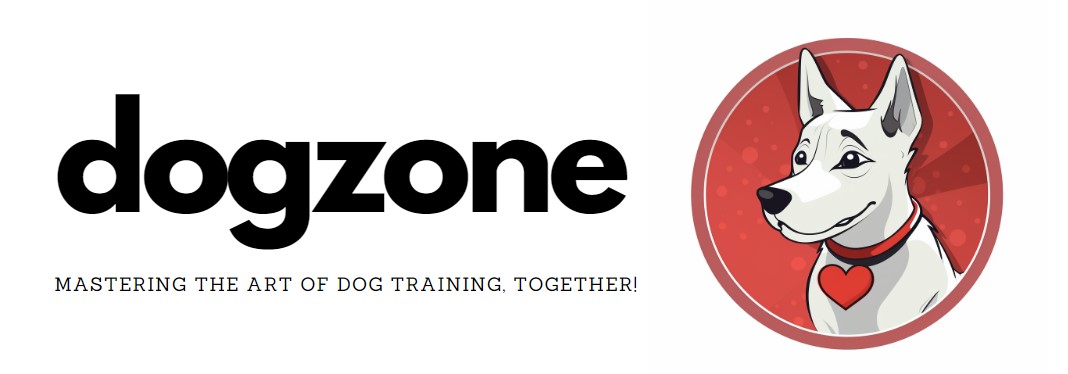
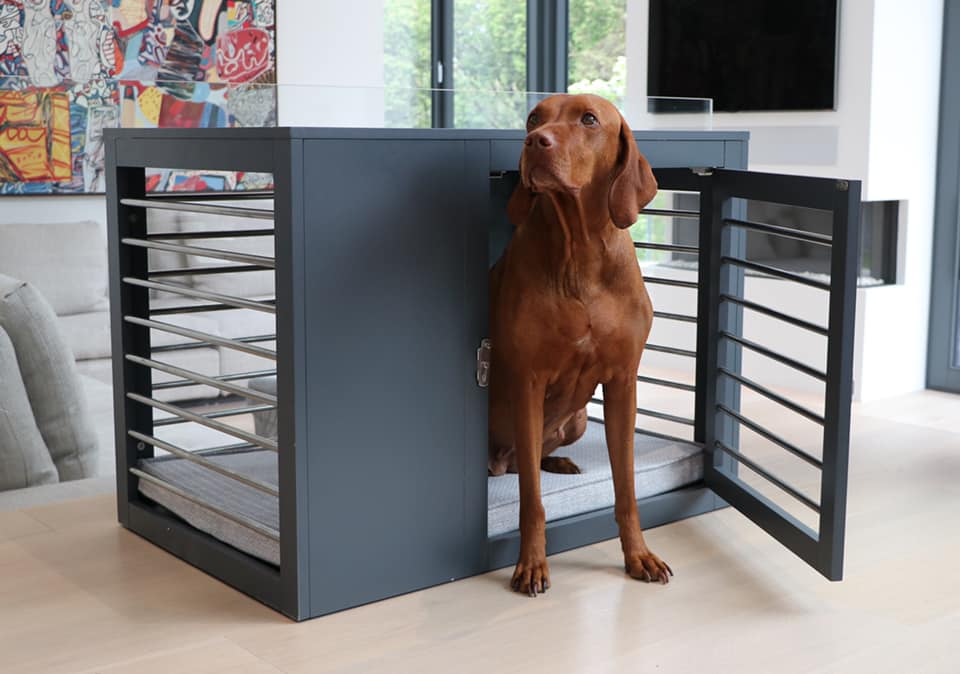
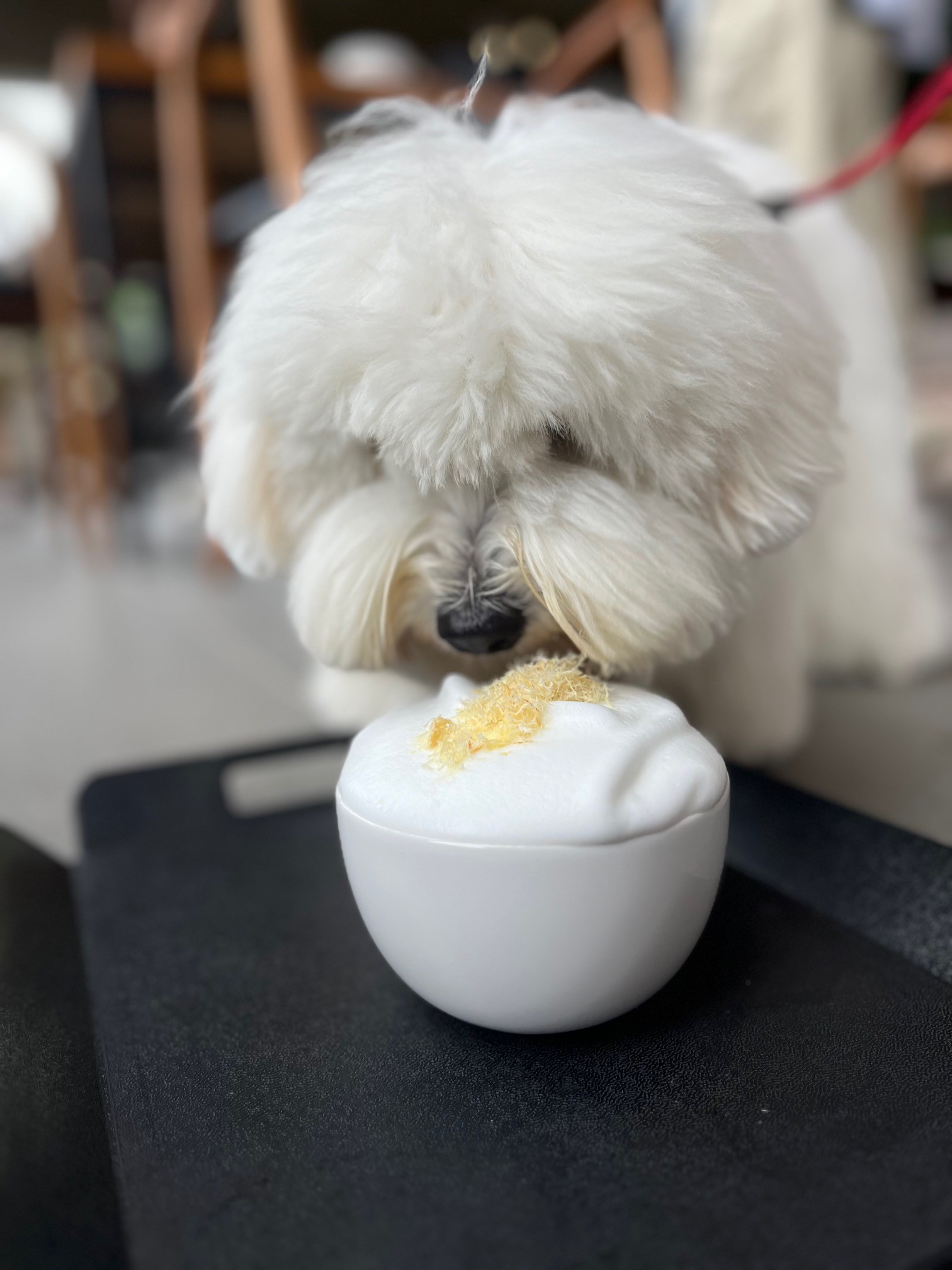
Leave a Reply